
Fatih is a municipality and district of Istanbul Province, Turkey. Its area is 15 km2, and its population is 368,227 (2022). It is home to almost all of the provincial authorities but not the courthouse. It encompasses the historical peninsula, coinciding with old Constantinople. In 2009, the district of Eminönü, which had been a separate municipality located at the tip of the peninsula, was once again remerged into Fatih because of its small population. Fatih is bordered by the Golden Horn to the north and the Sea of Marmara to the south, while the Western border is demarked by the Theodosian wall and the east by the Bosphorus Strait.

Nevşehirli Damat Ibrahim Pasha served as Grand Vizier for Sultan Ahmed III of the Ottoman Empire during the Tulip period. He was also the head of a ruling family which had great influence in the court of Ahmed III. The epithet "Nevşehirli" is used to distinguish this Grand Vizier from another, Damat Ibrahim Pasha.
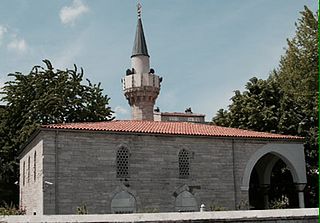
The Defterdar Mosque, or the Defterdar Mahmut Efendi Mosque, is 16th century Ottoman mosque located in Eyüp, Istanbul, Turkey. It was commissioned by defterdar Nazlı Mahmut Efendi and built by architect Mimar Sinan in 1542. Instead of a crescent, this mosque has "ink pot and pen" on top of its dome, representing the profession of the founder of the mosque. The original pair was broken by a storm in 1997. Ten years later, on 30 May 2007, a new inkpot and a pen assembled on top of the dome of the mosque.

Vefa is part of the district of Fatih in Istanbul, and lies inside what was once the old walled city of Constantinople. It lies roughly northwest of the eastern section of the Aqueduct of Valens, and is rich in monuments, both Byzantine and Ottoman. It takes its name from the Muslim saint (wali) Shaykh Ebu’l Vefa who is buried locally in his own mosque and dergah.

The Nuruosmaniye Mosque is an 18th-century Ottoman mosque located in the Çemberlitaş neighbourhood of Fatih district in Istanbul, Turkey, which was inscribed in the Tentative list of World Heritage Sites in Turkey in 2016.
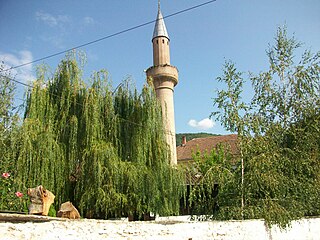
The Muderis Ali Efendi Mosque, also named Mosque of Ali Hoxha, is a mosque in Prizren, Kosovo. Built between 1543 and 1581, it is one of the oldest mosques in Kosovo. It is situated on the street "Rr. Papa Gjon Pali" down the hill from the Catholic Cathedral of Prizren, with its triangle shaped space it occupies 877 m 2, it was declared by Prizren Municipality in 1989 as a cultural monument. Its founder, Ali Effendi, who was at that time the Muderis of Prizren is buried in the garden. After the Second World War it was used as a Red Cross center and was heavily damaged because of the improper conduct. In 1963 fire broke out and thus damaged the Mosque even more, because of these events it lost its originality of an old monument. It was famous for the 1908 three year boycott of catholic shops in Prizren.

Hazret Süleyman Hilmi Tunahan was born in 1888 (1305AH), in the village of Ferhatlar, from the town of Hazergrad, in the province of Silistra, which today lies within Bulgaria. His father Hojazade (2) Osman Fawzi Efendi (1845_1928) was well know dar's al_Ām (3) of the time, who completed his studies in Istanbul. He taught for many years, at Satirli and Haci Paşa Madaris (4).His mother, was Hatije (Khadija) Hanım (5). His grandfather, Mahmud Efendi died aged nearly 110. He was known as Kaymak Hafiz.

Selamsız is a quarter in Üsküdar district on the Asian side of Istanbul, Turkey. It corresponds more or less to the current officially recognized neighborhoods of Selamiali and Muratreis. These neighborhoods are bounded on the north by Sultantepe, on the north and northeast by İcadiye, on the east by Altunizade, on the south by Valide-i Atik, and on the west by Mimarsinan.

Aziz Mahmud Hudayi (1541–1628),, is amongst the most famous Sufi Muslim saints of the Ottoman Empire. A mystic, poet, composer, author, statesman and Hanafi Maturidi Islamic scholar, he was the third and last husband of Ayşe Hümaşah Sultan, granddaughter of Sultan Suleiman the Magnificent.
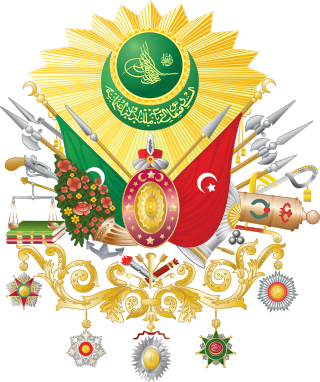
The following outline is provided as an overview of and topical guide to the Ottoman Empire:
Nizamiye Masjid, often called the Nizamiye Mosque, is a mosque situated in the city of Midrand, City of Johannesburg Metropolitan Municipality, South Africa.

Mahmut Ustaosmanoğlu, usually referred to as Mahmut Effendi and known to his disciples as "Efendi Hazretleri", was a Turkish Sufi Sheikh and the leader of the influential İsmailağa jamia of the Naqshbandi-Khalidiyya Ṭarīqah centred in Çarşamba, Istanbul.

Yahya Efendi or Molla Shaykhzadeh ul Yahya, Ottoman Islamic scholar, sufi sheikh, and poet buried in Beshiktash, Istanbul.
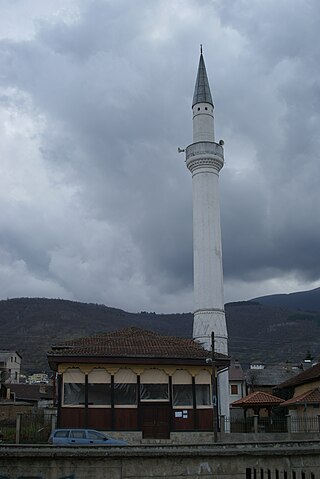
Suzi Çelebi of Prizren, in Turkish Prizrenli Suzi Çelebi, was an Ottoman poet and historiographer. He is remembered for his epic poem Gazavatnama Mihaloğlu which narrates the 15th-century Balkan conquests of the Ottomans, and the battles and glory of the military commander Ali Bey Mihaloğlu, being one of the most-known poetic works of the 15th century in overall.
Kınalızâde Hasan Çelebi was an Ottoman poet and bibliographer of the 16th century. His main work is the Tezkiretü'ş-Şuara, one of the best known Ottoman tezkires.

Zagan Pasha Mosque is a historic mosque in Balıkesir, northwest Turkey. It is known as the place, where Mustafa Kemal Atatürk delivered his famous "Balıkesir Khutbah" in 1923.

Laleli Mosque is a mosque in the Abdi Çavuş quarter of the walled city of Nicosia, currently located in North Nicosia. It is located on Ali Ruhi Street. Its name, meaning "the Mosque with Tulips", is thought to be derived from the tulip motifs adorning its original minaret. Originally a small medieval chapel, it was enlarged and converted to a mosque in the 19th century.

Nallı Masjid, also known as İmam Ali Mescidi or Babıali Mescidi, is a late 19th-century small mosque located at Ankara Street northwest of the historic Sublime Porte building, at Cağaloğlu quarter of Fatih district of old Istanbul, Turkey.
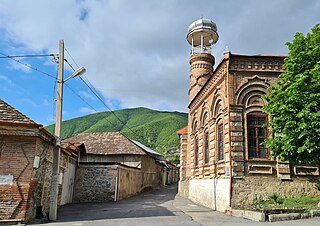
Omar Efendi Mosque is a historical and architectural monument of the 19th century located in the city of Sheki, Azerbaijan.
Zenbilli Ali Cemali Efendi Ottoman mufti, Islamic scholar (alim), shaykh al-Islam, Sufi, and minister. Zenbilli Ali was the son of Ahmed Çelebi, the grandson of Cemaleddin Aksarayi, a descendant of Fahraddin al-Razi. Since he is the descendant of Cemaleddin Aksarâyî, he is referred to with the title of Cemali, like his contemporary relatives and other statesmen and scholars. He was known among the people as "Zenbilli mufti" and "Zenbilli Ali Efendi", because he took people's questions with a weaved basket (zenbil) hanging from the window of his house in order to conclude the affairs of those who applied to him for a fatwa in a short time and put the answers back in the zenbil.















